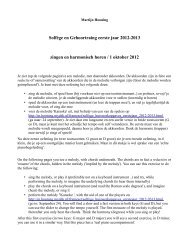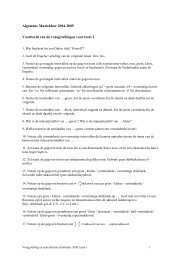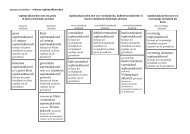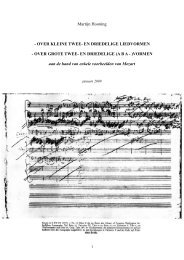Martijn Hooning SOME REMARKS ON SONATA FORM with an ...
Martijn Hooning SOME REMARKS ON SONATA FORM with an ...
Martijn Hooning SOME REMARKS ON SONATA FORM with an ...
Create successful ePaper yourself
Turn your PDF publications into a flip-book with our unique Google optimized e-Paper software.
Below you see <strong>an</strong> outline of a sonata form. In the outline a (fictitious) sonata in C major is<br />
assumed, along <strong>with</strong> a (also fictitious) sonata in c minor. We have to assume that both sonatas were<br />
composed between (ca.) 1780 en 1820: in the early Classical era dividing lines between the sections<br />
of the form often are less clear (especially between first group <strong>an</strong>d tr<strong>an</strong>sition); from the later pieces<br />
of Beethoven, <strong>an</strong>d certainly from the early Rom<strong>an</strong>tic period (e.g. Schubert) the key pattern often is<br />
different..<br />
When looking at the keys it is notable that:<br />
- in sonatas in a major key the keys of the two themes are a fifth apart; in Classical sonatas in a<br />
major key we find in the exposition both the home key <strong>an</strong>d the domin<strong>an</strong>t key.<br />
- in sonatas in a minor key the keys of two themes are most often a minor third apart: in Classical<br />
sonatas in a minor key we find in the exposition both the home key <strong>an</strong>d the relative major key. Use<br />
of the domin<strong>an</strong>t key instead of the relative major key in minor is exceptional. When the domin<strong>an</strong>t<br />
key is used, it is always the minor domin<strong>an</strong>t key!<br />
Such key relations are not only used in sonata forms; the relations home key/domin<strong>an</strong>t key or home<br />
key/domin<strong>an</strong>t key are also the most common relations in for example other sonata movements, <strong>an</strong>d<br />
for inst<strong>an</strong>ce in the d<strong>an</strong>ces in a Suite.<br />
In the outline below I am using capitals to indicate major keys, <strong>an</strong>d normal characters for minor<br />
keys.<br />
section<br />
(SLOW INTRODUCTI<strong>ON</strong>)<br />
Most sonatas do <strong>with</strong>out a slow introduction, but adding a slow<br />
introduction before the exposition is not uncommon. In a slow<br />
introduction the tempo is for example: largo, adagio or something<br />
similar. At the beginning of the exposition there is a tempo ch<strong>an</strong>ge<br />
(the tempo is ch<strong>an</strong>ging to Allegro, for inst<strong>an</strong>ce).<br />
Often a slow introduction is aiming at the domin<strong>an</strong>t of the home<br />
key, usually V or V7 (so in this example we will reach a G- or G7chord<br />
at the end of the introduction); the resolution of this<br />
domin<strong>an</strong>t is at the start of the exposition: the exposition is starting<br />
on the triad of I .<br />
EXPOSITI<strong>ON</strong><br />
first theme (or: first group)<br />
This section sometimes constists of more then just one musical<br />
phrase. In such cases it might be a better idea to speak of a first<br />
group. Apart from that: I believe the term 'group' for a themetic<br />
section in a sonata form is nowadays more common in English<br />
then 'theme'.<br />
A first group may end <strong>with</strong> <strong>an</strong> authentic c<strong>an</strong>dence in the home key<br />
(<strong>an</strong>d will form thus a 'closed entity'). It may also end <strong>with</strong> a half<br />
4<br />
keys in a<br />
sonata in<br />
C major<br />
keys in a<br />
sonata in<br />
c minor<br />
(most<br />
common)<br />
C c c<br />
C c c<br />
keys in a<br />
sonata in<br />
c minor<br />
(sometimes)






